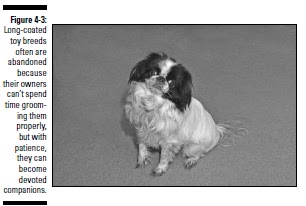Examples of common companion dogs include Yorkshire Terriers, Poodles,
Shih Tzu, Chihuahuas, Pugs, Pomeranians, Maltese, Lhasa Apsos, Miniature
Pinschers, Bichon Frise, Cavalier King Charles Spaniels, Papillon, Pekingese,
French Bulldogs, Bulldogs, Havanese, Boston Terriers, and Italian Greyhounds.
See Figure 4-3 for an example of a Japanese Chin, a purebred companion dog
you may find at a shelter.
Imposing Guardian breeds
These large, powerful dogs make excellent companion dogs and sometimes
perform other tasks like pulling heavy loads, but they’ve served humans for
thousands of years primarily as guardians. Long ago, when such barbaric
practices were legal, these dogs also fought for sport. Exceptionally strong
animals, they retain an instinct to protect their humans and their property.
Because Guardian breeds are so strong, training and active socialization at an
early age is absolutely crucial. Many of these breeds are big softies with their
owners and friendly with friends . . . but evil-doers beware.
These dogs never should be left outside alone in the yard all day. They need
frequent human interaction to make the most of their intelligence and plenty
of exercise and owner interaction so they don’t become bored and destructive.
Many Guardian breeds don’t bark much unless they have a good reason
or they’re left alone too often. They also tend to have a good natural instinct
about people. Early socialization helps refine this instinct so the dog becomes
trustworthy around children, neighbors, and friends.
Born to run: Cold-hardy Northern breeds
Arctic dogs tend to have prick ears, curled tails that swoosh over their backs,
heavy frost-proof coats, and strong feet made for running and padded with
fur. These dogs have extreme drive and have served many purposes in frigid
climates, pulling sleds, guarding, hunting, and warming the beds of their
companions.
Northern breeds tend to be independent with a strong survival instinct and,
in many cases, a strong instinct to run. They don’t tolerate warmer weather
but love the cold often sitting for hours out in the snow. They’re clever escape
artists, so they need secure fences and supervision and always need to wear
identification. (All dogs should, for that matter, but it’s especially important
for escapees.) Good owners for Northern breeds include active families, people
who live in areas where these dogs can safely run, and people who want to
get involved in fun sports like dog sledding, skijoring (dogs pulling crosscountry
skiers), carting, and weight pulling. If you want a challenging dog
that sees you as an equal but is willing to follow your rules if you earn his
respect, this may be your group.
Examples of Northern breeds include Siberian Huskies, Chinese Shar-Pei,
Alaskan Malamutes, Akitas, American Eskimos, Chow-Chows, Keeshonds,
Norwegian Elkhounds, Samoyeds, and Shiba Inus.
Eye on the prize: Sighthounds
Sighthounds are among the oldest types of dogs. These long, lithe, speedy
runners have supersharp eyesight and long were bred to spot prey from far
away — even across dessert sands — and chase it down, fast. Greyhounds
are among the original Sighthounds, but many other Sighthounds have
evolved from greyhounds.
Sighthounds are an interesting combination of independent and sensitive.
They won’t smother you or beg for affection, but they may sit nearby pining
for your attention. Sighthounds need secure fencing and strong leashes, or
they can dash into traffic after a squirrel or rabbit. When chasing something,
they don’t notice anything else, thus few Sighthounds ever are trustworthy
off leash no matter how well trained. They won’t even hear you yelling “Come!”
Sighthounds are often depicted in art because of their slim curvy forms and
beautiful lines.
Examples of common Sighthounds include Greyhounds, Afghan Hounds,
Whippets, Salukis, Scottish Deerhounds, Irish Wolfhounds, Basenjis, and
Rhodesian Ridgebacks.
Born to run: Cold-hardy Northern breeds
Arctic dogs tend to have prick ears, curled tails that swoosh over their backs,
heavy frost-proof coats, and strong feet made for running and padded with
fur. These dogs have extreme drive and have served many purposes in frigid
climates, pulling sleds, guarding, hunting, and warming the beds of their
companions.
Northern breeds tend to be independent with a strong survival instinct and,
in many cases, a strong instinct to run. They don’t tolerate warmer weather
but love the cold often sitting for hours out in the snow. They’re clever escape
artists, so they need secure fences and supervision and always need to wear
identification. (All dogs should, for that matter, but it’s especially important
for escapees.) Good owners for Northern breeds include active families, people
who live in areas where these dogs can safely run, and people who want to
get involved in fun sports like dog sledding, skijoring (dogs pulling crosscountry
skiers), carting, and weight pulling. If you want a challenging dog
that sees you as an equal but is willing to follow your rules if you earn his
respect, this may be your group.
Examples of Northern breeds include Siberian Huskies, Chinese Shar-Pei,
Alaskan Malamutes, Akitas, American Eskimos, Chow-Chows, Keeshonds,
Norwegian Elkhounds, Samoyeds, and Shiba Inus.
Eye on the prize: Sighthounds
Sighthounds are among the oldest types of dogs. These long, lithe, speedy
runners have supersharp eyesight and long were bred to spot prey from far
away — even across dessert sands — and chase it down, fast. Greyhounds
are among the original Sighthounds, but many other Sighthounds have
evolved from greyhounds.
Sighthounds are an interesting combination of independent and sensitive.
They won’t smother you or beg for affection, but they may sit nearby pining
for your attention. Sighthounds need secure fencing and strong leashes, or
they can dash into traffic after a squirrel or rabbit. When chasing something,
they don’t notice anything else, thus few Sighthounds ever are trustworthy
off leash no matter how well trained. They won’t even hear you yelling “Come!”
Sighthounds are often depicted in art because of their slim curvy forms and
beautiful lines.
Examples of common Sighthounds include Greyhounds, Afghan Hounds,
Whippets, Salukis, Scottish Deerhounds, Irish Wolfhounds, Basenjis, and
Rhodesian Ridgebacks.

Aucun commentaire:
Enregistrer un commentaire